7 Features We Hope iPhone 17 Borrows from Google & OpenAI

▼ Summary
– The Google Pixel 10’s deeply integrated AI features highlight key gaps the iPhone 17 must address to remain competitive.
– Apple could partner with existing AI apps like ChatGPT or Claude for deeper system-level integration rather than building from scratch.
– Google’s new AI camera capabilities, such as Pro Res Zoom and Best Take, present significant advantages over current iPhone offerings.
– Features like Magic Cue demonstrate how AI can streamline tasks by accessing personal data across apps while maintaining privacy assurances.
– Apple lags in language support and conversational photo editing, areas where Google and other AI services have made substantial progress.
The upcoming iPhone 17 faces a critical challenge: integrating advanced AI capabilities that competitors like Google and OpenAI are already embedding deeply into their devices. While Apple’s ecosystem hosts many leading AI applications, the real opportunity lies in weaving these tools directly into the operating system for a more seamless and powerful user experience.
One standout feature users hope to see is a more intuitive voice assistant. OpenAI’s ChatGPT Voice Mode demonstrates how natural, conversational interaction can enhance daily tasks. Although it’s possible to assign this function to the iPhone’s Action Button, a native integration, or a formal partnership with OpenAI, could allow deeper access to calendars, messages, and system settings, all while upholding Apple’s strong privacy standards.
Another area where Apple could learn from Google is in computational photography. The Pixel 10’s Pro Res Zoom uses AI to dramatically improve digital zoom, producing usable images even at extreme magnification. Given Apple’s own expertise in imaging, a similar system-level feature could finally close the gap for mobile photographers who still rely on dedicated cameras for quality zoom shots.
Contextual awareness is another frontier. Google’s Magic Cue uses on-device intelligence to surface relevant information, like dinner reservations pulled directly from an email, without requiring users to switch between apps. Apple’s announced but yet-to-ship Personal Intelligence feature suggests a similar vision, but timely execution will be key to matching Google’s head start.
For research and information gathering, Anthropic’s Deep Research tool stands out for its accuracy and citation of sources. Integrating a similar capability into Siri would allow iPhone users to conduct in-depth queries using voice or text, turning the assistant into a powerful research tool without leaving the Apple environment.
Group photography is another pain point Apple could address. Google’s Best Take and Add Me features use AI to combine multiple shots into one ideal image, even inserting the photographer when needed. These are exactly the kind of smart, automated solutions that would feel right at home within iOS, leveraging Apple’s computational photography strengths or through a licensing agreement.
Language support is another critical area. While Apple Translate currently handles 20 languages, rivals like Google support over 100. Expanding this through large language models would improve not only translation apps but also real-time features like live call translation and visual text recognition, making the iPhone more useful to a global audience.
Finally, Google’s conversational photo editing allows users to describe changes in natural language, with AI executing complex edits automatically. This kind of accessibility could bring advanced photo manipulation to everyday users, and with proper sensitivity to context and authenticity, it could become a widely adopted tool.
Apple has the resources and talent to incorporate these innovations, but the clock is ticking. As AI becomes increasingly central to the smartphone experience, the iPhone 17 must deliver system-level intelligence that feels native, intuitive, and genuinely useful, or risk falling behind in a rapidly evolving market.
(Source: ZDNET)





